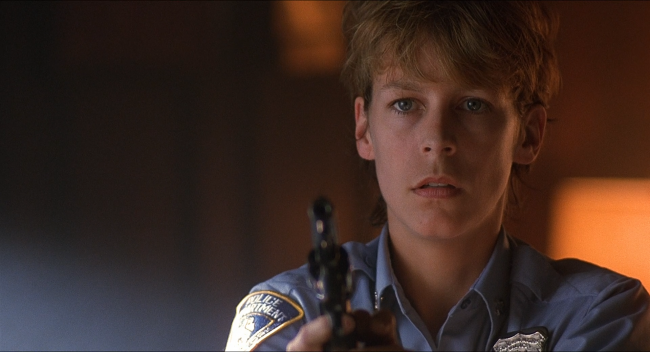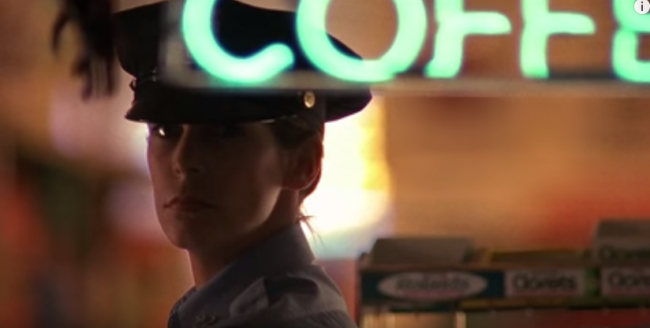That Moment In ‘Blue Steel’ (1989): Awakening the Monster
Blue Steel is a crime thriller about a sociopath who acquires a gun and goes on a rampage, eventually targeting the female police officer who was responsible for losing the gun in the first place. Ahead of its time, this tense police drama is well-acted but even better directed.
One look at the 1980s cop movie genre and it doesn’t take long to see a common theme: One man, almost always white, single handedly takes out all the bad guys. John McClane, Sharkey, Cobra Cobretti, Mark Kaminsky, and Alex Murphy, are only a few, though there were some partners in the mix and even one comedian, Axel Foley. Men dominated the decade with only a few minor roles for women, including Nancy Allen in Robocop, and Kim Cattrall and Marion Ramsey in the slapstick comedy Police Academy. By the end of the decade, the ‘everyman’ hero was the 80s movie trope calling card, with stress on ‘man’.

Along came writer director Kathryn Bigelow, who two years early had lots of people talking about her indie cult film Near Dark. It was a story about a boy turned into a vampire but with a lot more subtext. That movie was built upon the success of a current trend in teenage vampires (something that would swing around again a few more times). With Blue Steel, she turned her attention to the policeman genre and the first order of business was to flip that from man to woman. Casting horror scream queen turned sex symbol Jamie Lee Curtis might have been a risk. Even more so as the movie made great steps in reducing her sex appeal, though there is an obligatory sweaty 80s sex scene. However, much of the focus is on her character rather than her body.
The film itself didn’t do well at the box office. It has since developed a following. In light of Bigelow’s accomplishments since, including an Academy Award for Best Picture (The Hurt Locker, 2010), it deserves a second look. This is a highly underrated film with great thrills and two terrific performances. Let’s look closer at one of many pivotal scenes, where a rookie cop’s actions are questionable and a serial killer is born.
Awakening the Monster
Megan Turner (Curtis) is fresh out of the academy and dressed in blue for her first day on the job as a New York City cop. Naturally, she’s been dealing with questions about her choice to be a policewoman. Why would a beautiful woman want to be a cop? Her reply is spot on. Either way, she’s happy and feeling confident. As she and her male partner hit the streets in their patrol car, they stop at a bodega. Her partner dips into the restroom while she stacks the counter with a few snacks and orders coffee. Meanwhile, she glances across the street to Sloan’s Supermarket.
Let’s stop right here. There’s some key things happening already. First off is the setting. It’s late evening, the space between the bodega and the market is lit with neon from the stores. We get a great establishing shot of an edgy, excited Turner. She looks the part but is clearly searching for room to get her bearings. In a way, it feels a little like dress up but the reality is sinking in.

With the glance across the way, we catch sight of the grocery store. The windows are big and wide, gleaming in the ebony night. The sign above reads ‘SLOAN’S’ and directly under that is a sharply-dressed man in a tan suit (Ron Silver) walking right to left inside the mart.

What we don’t know yet, is that this man will have great significance. And it will be Turner that sets him into play. But more important is the sign and his movement under it. The word Sloan might seem innocuous but it isn’t. A Gaelic word, it means ‘warrior’ and Bigelow slowly pans across it as the man in the suit casually strolls beneath it. The camera cuts back to Turner, watching, and we sense she’s already seeing something we don’t.

Now we leave her for a moment and enter the grocery store and this time, the man in the tan suit is front and center reading what looks like a list. He searches for selected items. He looks calm, business-like, invisible. It then cuts to the opposite. An imposing figure (Tom Sizemore) in black jeans, leather jacket and cap, gruffly strolls toward the camera. Naturally, with years of movies about similarly-dressed characters embedded into our brains, we know exactly who he is. Trouble.

He gets to the counter and pulls from his jacket a Smith & Wesson Model 29 hand-cannon and instructs everyone to get on the floor. He then points the gun at the clerk. Right away, everyone complies, including the man in the tan suit who hits the deck. He is only a few feet from the gunman.

We see fear in the prone man. We later will learn is named Eugene Hunt, another clue to his personality. In all likelihood, it is the first time he’s been this close to a weapon. It’s terrifying, and so far, we have no reason to suspect anything malicious about him. We’ve now seen him three times though, so we’re on alert.
Back at the bodega, Turner is seeing it all unfold. She hesitates for a moment, knocking over the fresh cup of coffee as adrenaline pours into her system. Bigelow pans down to the spilled coffee and gives a little sign of the times, subliminally signaling to us that things are about to be different.

Turner looks back to the rear of the bodega. Her partner indisposed, she spins back around to the front. We see a wide shot of the store’s name again. It fills the screen. While most in the audience won’t understand the word’s meaning, it still works as a sign marking a crossroad. But since we do know the meaning, the implication is clear. She must be the warrior.

She then bolts out the door and runs to the back entrance of the grocery store. Her gun unholstered, she enters the building. Needless to say, she is terrified. Pay attention to the lighting. As she enters the rear of the building, she is bathed in near shadow. Her face is almost unseen as she weakly pushes across the stock room.

She then emerges from the swinging doors into slightly brighter light. Gathering her wits, by the time she reaches the end of the aisle, she is looking much more collected. She is also standing in full light.The rookie is out of the shadows. Can she perform?

At last, she is in view of the assailant. He is busy directing the clerk to give him the money. It’s decision time. She pulls back a moment to concentrate and reflect on the hesitation she had in training during a practice hostage situation, something we saw at the start of the movie. With no time and the armed man growing more angry, she finally makes her move. She approaches, pistol pointing forward and loudly identifies herself. The thief replies by turning his gun on her, looking to fire. Turner pulls the trigger first and empties her pistol into his chest, sending him reeling through the plate glass window behind him.

In the exchange, the robber loses his grip on his gun and it flies out of his hand. It lands directly in front of Eugene Hunt. It comes to a stop just inches from his face.

This is the moment when we realize why the man has significance. In the chaos of the moment, Hunt watches carefully, and in a bold move, gingerly puts his hand on the gun and draws it into jacket, outright stealing it from the crime scene. There is an exhilaration in the man’s eyes, a frightening awakening in his face that suggests this is more than a curiosity. This is opportunity.

Eugene is not a good man. You’ll have to watch the film to learn why, but it is this moment in the grocery store that gives the beast within him the open door it’s been waiting for. As we’ve seen many times since, Bigelow is especially good at building suspense, creating tension with action and visuals rather than dialog. This moment is carefully designed to create a specific expectation but trips us up and steers us onto another path. With the focus on the leather-jacketed robber, we know there will be violence. That’s Screenwriting 101, giving the hero the first trial by fire. Eugene is the twist and watch how Bigelow makes a fantastic shift from Turner to Hunt as she walks past him as he lays on the floor, bypassing the pistol. We only see her legs as she walks through the field of view, but her dark pant legs act like a screen wipe, marking Hunt’s transformation.

Even as it shifts back to Turner as she stares in shock at her handiwork, we aren’t thinking about the thief. Our eyes scan the scene in search of the tan-suited man and a new expectation takes hold. The story has officially begun.

Blue Steel is an excellent police thriller that if anything, should be watched just for Bigelow’s outstanding direction. This moment triggers a vicious game of cat and mouse that gets highly personal, leading to a great shootout with a difficult choice at its end. A solid thriller with many familiar tropes, it has a sharp style and works supremely well for what it is.
